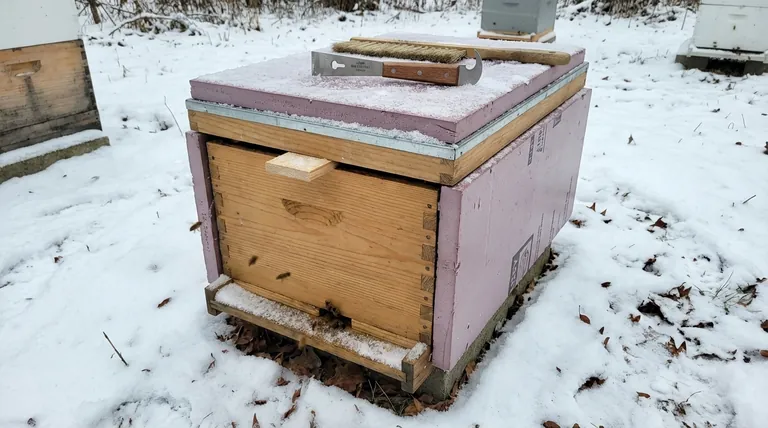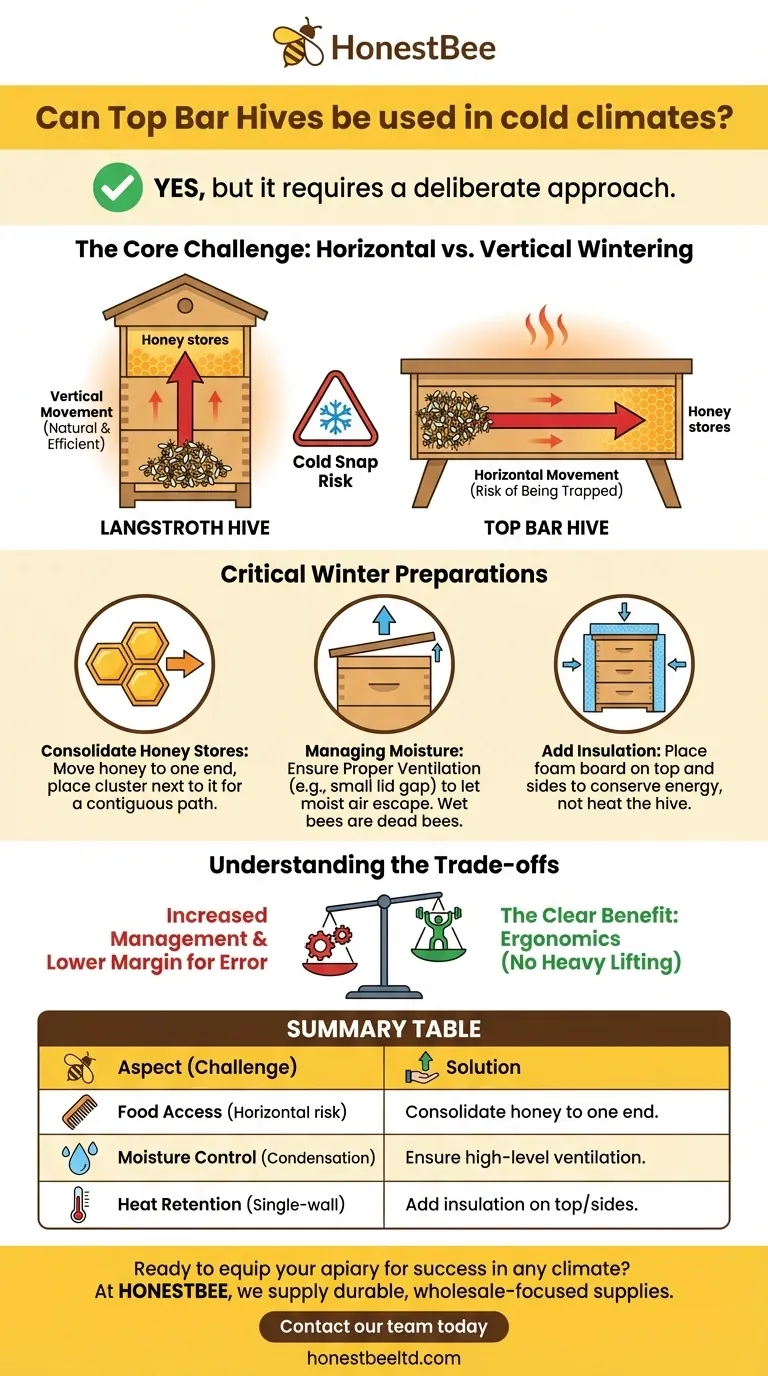Yes, a top bar hive can absolutely be used in a cold climate, but its success is not automatic. Unlike a standard Langstroth hive, the horizontal design of a top bar hive requires a more deliberate and informed approach from the beekeeper to manage winter food stores and, most critically, moisture.
The primary challenge of wintering a top bar hive is not the cold itself, but managing the colony's horizontal movement toward food and ensuring moisture from the bees' respiration can escape without chilling the hive.

The Core Challenge: Horizontal vs. Vertical Wintering
To understand how to succeed, you must first grasp how a hive's shape impacts the bee's natural winter behavior.
How a Winter Cluster Behaves
Honey bees do not heat the entire hive. Instead, they form a tight winter cluster to generate and share warmth, maintaining a core temperature of around 95°F (35°C).
This cluster consumes honey for energy. As they finish the honey in one area, the entire cluster must move together to a new section of comb.
The Langstroth Advantage: Vertical Movement
In a standard vertical Langstroth hive, the bees naturally store honey above their brood nest. As winter progresses, the cluster consumes honey and slowly moves upward, following their own rising heat.
This upward path is instinctive and highly efficient, keeping the cluster in constant contact with its food source.
The Top Bar Hive Disadvantage: Horizontal Movement
In a top bar hive, the honey and the cluster are arranged horizontally. To reach new food stores, the cluster must move sideways along the bars.
This horizontal movement is less natural and presents a significant risk. A cold snap can "trap" the cluster, preventing it from breaking formation to move just a few inches to an adjacent comb full of honey. This is a common cause of winter starvation in poorly prepared top bar hives.
Critical Winter Preparations for Top Bar Hives
Your entire winter strategy revolves around making this horizontal journey as short and easy as possible while keeping the bees dry.
Consolidate Honey Stores
Before winter, you must organize the combs. Move all the honey-filled combs to one end of the hive, placing the brood nest and the bee cluster right beside them.
This creates a single, contiguous path of food. The bees will start at one end and eat their way towards the other, minimizing the distance they need to travel. Remove any empty combs from the far end and use a "follower board" to reduce the total interior space the bees need to manage.
Managing Moisture: The Real Killer
A colony can survive extreme cold if it is dry and has food. However, moisture from the bees' own respiration is deadly. This warm, moist air rises, condenses on the cold inner lid, and drips back down onto the cluster.
Wet bees are dead bees. Your top priority is to give this moisture a way to escape.
Ensure Proper Ventilation
Proper ventilation removes moist air without creating a cold draft. Create a small, high-level exit point for air.
You can achieve this by placing a small shim (the size of a popsicle stick) under one end of the lid to create a slight gap. Some beekeepers also use "quilt boxes"—a shallow box with wood shavings on top of the bars—to absorb moisture.
Add Insulation
Insulation helps the bees conserve energy. Place rigid foam board insulation on top of the lid and against the sides of the hive.
The goal isn't to heat the hive, but to reduce heat loss. This allows the cluster to use more of its energy reserves for survival rather than just staying warm.
Understanding the Trade-offs
A top bar hive is a valid choice for any climate, but you must be objective about its demands compared to other systems.
Increased Management Demands
A top bar hive requires more thoughtful preparation for winter than a Langstroth. You cannot simply stack honey boxes and hope for the best. You must actively organize the combs and monitor the hive's configuration.
Lower Margin for Error
Because of the horizontal layout, mistakes in preparation are more likely to be fatal. A cluster that gets stranded from its food source will starve quickly, even if ample honey is just one comb away.
The Clear Benefit: Ergonomics
The primary reason many beekeepers choose top bar hives is the lack of heavy lifting. Managing individual bars is far less physically demanding than lifting 50-pound honey supers, making it a sustainable option for many people.
Making the Right Choice for Your Goal
Whether a top bar hive is right for you depends on your priorities and willingness to meet its specific needs.
- If your primary focus is a forgiving, low-intervention system: A Langstroth hive is generally easier to winterize successfully, especially for new beekeepers, due to its vertical design.
- If you are committed to the natural beekeeping philosophy of a TBH: It is an entirely viable system in the cold, provided you master the principles of moisture control and honey consolidation.
- If your primary focus is avoiding heavy lifting: A top bar hive is an excellent choice, but you must dedicate yourself to learning and applying these specific wintering techniques without fail.
Your success in any hive depends on understanding the bees' needs and using the hive's design to help them thrive.
Summary Table:
| Aspect | Challenge in Top Bar Hives | Key Solution |
|---|---|---|
| Food Access | Cluster must move horizontally, risking starvation. | Consolidate honey combs to one end before winter. |
| Moisture Control | Condensation can drip and kill the cluster. | Ensure high-level ventilation (e.g., a small lid gap). |
| Heat Retention | More heat loss due to single-wall design. | Add insulation on top and sides to conserve energy. |
Ready to equip your apiary for success in any climate?
At HONESTBEE, we supply commercial apiaries and beekeeping equipment distributors with the durable, wholesale-focused supplies needed to thrive. Whether you manage Langstroth, Top Bar, or other hive systems, we have the equipment and expertise to support your operation.
Contact our team today to discuss your wholesale needs and ensure your bees are prepared for every season.
Visual Guide

Related Products
- HONESTBEE Professional Multi-Functional Hive Tool with Ergonomic Wood Handle
- Long Langstroth Style Horizontal Top Bar Hive for Wholesale
- HONESTBEE Advanced Ergonomic Stainless Steel Hive Tool for Beekeeping
- HONESTBEE Professional Long Handled Hive Tool with Precision Cutting Blade
- Multi-Function Plier-Style Frame Grip Hive Tool
People Also Ask
- What are the features of a J-hook hive tool? Effortlessly Lift Frames with Superior Leverage
- What safety precautions are advised for beekeeping with hive tools? Master Safe Handling for Calm, Efficient Hives
- What types of hive tools are available for beekeepers? Choose the Right Lever for Your Apiary
- What is a multifunction scraper hive tool? The All-in-One Solution for Efficient Beekeeping
- Why do hive tools have a hole? Unlock the Secret to Efficient Beekeeping



















